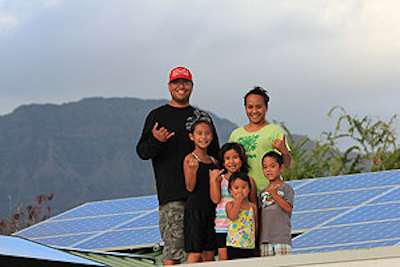
Oahu – The outrageous cost of Utility power in Hawaii has led tens of thousands of homeowners there to use off-grid solar-and-battery systems.
Residential electricity prices in the Aloha State averaged 31.2 cents per kilowatt hour in May, federal data shows. That is 2½ times the average U.S. price. Per kilowatt hour prices topped 40 cents on the Big Island.
No one is sure exactly how many Hawaiian homes use off-grid systems. Kawika Stevens, sales manager and chief solar technician for Off-Grid Solar Specialists, guesses that there are around 2,000 off-grid installations in the state.
Hawaiian Electric Co.(HECO) counted 51,000 hybrid systems on its power grids as of Dec. 31, 2014. About 12 percent of the company’s residential customers use grid-connected solar panels — compared with 0.5 percent in the rest of the U.S. HECO, which serves 95 percent of Hawaii, last year began restricting solar installations on parts of its system that can’t handle the extra power the panels produce
Stevens lives off-grid, and he and his family want for nothing electrically — “you can’t keep your girls from wanting to use hair dryers and their gadgets.”
But off-grid homeowners face some unique issues. Here are five of them:
Initial costs
Prices vary, but Stevens says a solar-and-battery system big enough to power a typical Hawaiian home can cost around $32,000. That’s only about $2,000 more than a more common grid-connected solar setup. Competition among installers is lowering costs of off-grid systems, Stevens said.
Rule of thumb: Hawaiian homeowners recover the costs of their off-grid systems after about five years — but the systems themselves last 20 to 25 years. With current technology, the batteries might need to be swapped out after 10 or 15 years, Stevens says. But the bottom line is that after five years, homeowners are powering their homes for free.
Special appliances
Solar panels produce direct current, while modern home appliances use alternating current. That’s a problem with major appliances like refrigerators or power-consuming devices like water pumps, since a lot of power is lost to the inverters that convert the panels’ direct current to alternating current.
The solution: Specially-built direct current, or DC, appliances that run on a separate circuit from a home’s alternating current, or AC, devices.
DC major appliances are expensive. A small, apartment-size 7.3-square foot DC refrigerator sells for $1,650; a similar AC refrigerator goes for around $400. Big DC refrigerators can run to $3,000. But paying more for efficient DC appliances is cheaper than adding extra solar panels and batteries to handle AC appliances, Stevens said.
AC computers, TVs, lights and other appliances don’t draw as much power as major appliances, so the electricity lost in the DC-to-AC conversion needed to run them is not a big issue. Stevens suggests his customers buy LED TVs, which use about two-thirds as much power as LCD sets.
Monitoring energy use
Solar panels churn out plenty of electricity in daylight. At night, Stevens’ home system draws from storage batteries. The systems include monitoring equipment that lets homeowners watch their battery performance. “It’s not something where you set them and forget them,” said Stevens. “It’s something you do want to at least monitor.”
He’s found that his customers over-monitor their systems for the first 30 to 60 days they live with them. “Once they realize they have everything they need, they monitor much less,” he said.
System maintenance
Homeowners must put some work into maintaining the systems. It’s not hard, “but you need to know what you’re doing,” said Mara Hisiger, who two months ago moved with John Rees into an 800-sqare foot off-grid home in South Kona, on the west side of the Big Island.
Their house came with an older off-grid system with liquid, golf-cart style batteries. Hisiger and Rees have to top off the batteries’ distilled water and keep the terminals clean — chores not required with newer sealed battery systems. Hisiger and Rees also have to make sure the system is fully charged every three weeks or so.
They also have to keep the solar panels clean — but Hisiger says that’s no problem, since it rains at their house nearly every day.
“Solar is awesome, and works as well as grid-tied electric,” Hisiger said.
Hot water and cooking
Propane gas is the best way to fuel a solar home’s hot water heaters, clothes dryers, and cooking ranges, Stevens says. Even in Hawaii — where all fuel is shipped in from elsewhere — running stoves and other heating appliances off propane is better than using solar-generated electricity.
“For a family of five or six, you are looking at $40 a month worth of propane to heat your water,” Stevens said. Because of Hawaii’s warm climate, he said, home heating isn’t an issue for his customers.
The off-grid systems Stevens installs are a step beyond grid-connected solar panels seen on tens of thousands of rooftops across Hawaii.
HECO’s restrictions aren’t a problem for Stevens’s clients. He and others in the solar industry hope for better battery technology from Tesla and other manufacturers. But in Hawaii, off-grid is working now. “People tend to like that they are in charge of their own power,” Stevens said.